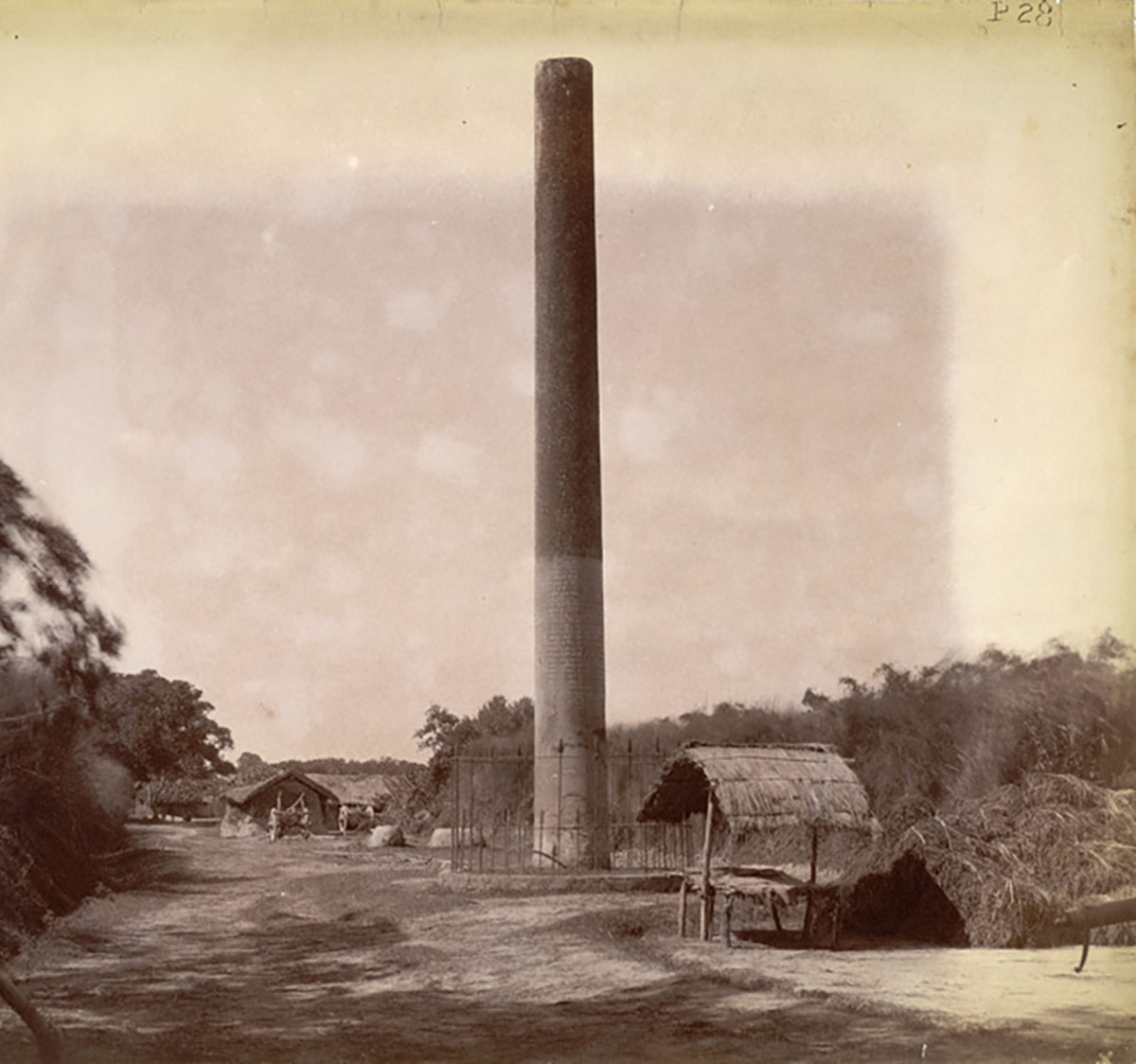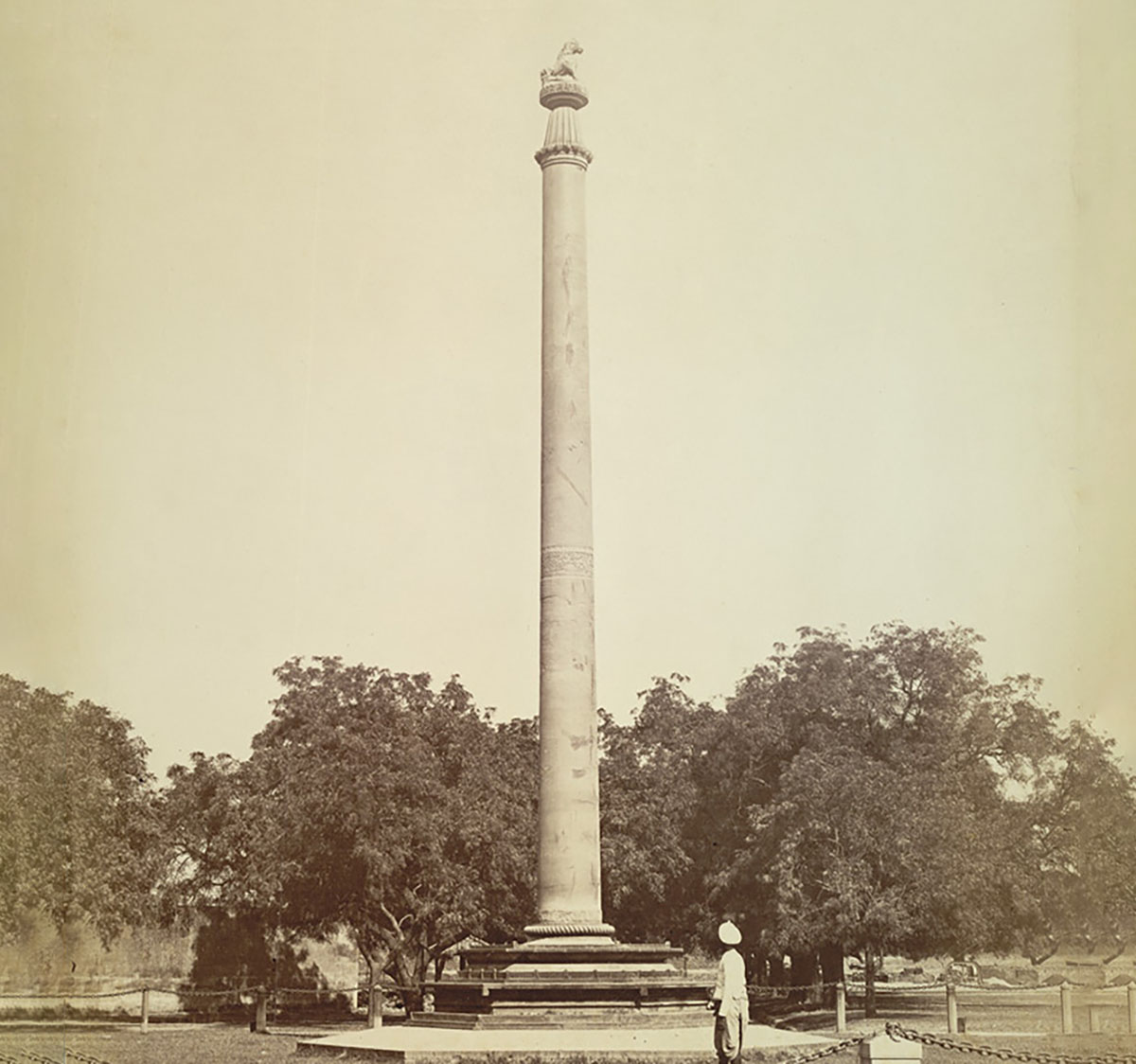ARTICLE
Pillars of Ashoka
A series of monumental free-standing columns across present-day India and Nepal, commissioned by the Mauryan emperor Ashoka (r. 268–232 BCE), are among the earliest examples of stone sculpture in the Indian subcontinent. Their carved, animal-shaped capitals form some of the most sophisticated works of art produced under Mauryan rule, and many of the pillars are inscribed with royal edicts. Their design is also thought to reveal the stylistic influence of Persian Achaemenid and Hellenistic architecture.
In the Indian subcontinent, the transition from wooden to stone sculpture and architecture is thought to have occurred during the reign of the Maurya dynasty, between 350 and 185 BCE. Stone pillars are considered the most characteristic and influential art historical legacy of the Mauryas — they were likely an adaptation of an earlier artistic tradition in wood, of which little has survived. The pillars attributed to Ashoka’s reign — some still standing and intact, and others in fragments — are a sophisticated expression of the general artistic tendencies of the Maurya empire.
Some scholars have suggested that Mauryan stone pillars build on an older, pre-Buddhist association of the pillar with the axis mundi or ‘world axis’, based on certain Brahmanical myths in which the creation of the world involved the separation of heaven and earth by a pillar or tree. The tradition of inscribing royal edicts on pillars and other stone surfaces is thought to predate Ashoka’s reign. Given that the Mauryan empire was the first empire of its scale in a region previously composed of disparate tribes and cults, Ashoka’s pillars and rock-inscribed edicts — on surfaces such as cave walls and boulders — would also have functioned as a display of power and authority from the centre of the empire to its more remote provinces. While the rock edicts have been found across the empire — as far west as modern-day Afghanistan and as far south as the Krishna River — a majority of Ashokan pillars have been found concentrated in present-day Uttar Pradesh, Bihar and Madhya Pradesh.
Ranging between 12 and 15 metres tall, the pillars are made of buff-coloured hard sandstone from Chunar in present-day Uttar Pradesh, northern India, or spotted red and white sandstone from Mathura, also in Uttar Pradesh. Historians have deduced that stone must have been transported from these areas to the places where the pillars were constructed and erected. The finished pillars are highly polished, a characteristic feature of Mauryan sculpture.
The Ashokan pillars comprise three parts: the footing which grounds the pillar in the earth, the smooth, tapered shaft, and the capital. The shaft and capital were typically made separately, often using two different types of stone, and then joined by a metal dowel. Some pillars featured stone slab footings, presumably to prevent sinking. Other pillars were set in foundation walls made of brick and clay. Because the pillars did not feature platforms at ground level, they appeared to rise directly out of the ground.
The pillar edicts, inscribed on the lower part of the shaft, are written in Ashokan Prakrit using the Brahmi and Kharoshthi scripts — along with Ashoka’s rock edicts, these are considered the earliest epigraphs from the Indian subcontinent. They are generally concerned with Ashoka’s policies of governance, which he proclaimed were based on the ideas of moral conduct and righteousness, and dhamma or the fundamental teachings of Buddhism. However, explicit mention of Buddhism is rare in the edicts and the extent of Ashoka’s adoption of Buddhism is debated by scholars.
The pillar capitals comprise three sections: a bell-shaped base typically rendered as an inverted lotus, topped by an *abacus* — a thick, wide slab — generally carved in low relief, on which stands the sculpted animal figure(s). The circumference of the capital between the base and the abacus is sometimes carved to resemble a rope. The animal sculptures of Ashokan capitals are noteworthy for their realistic rendering and precise anatomical detail. Out of the surviving capitals, one is sculpted with an elephant, one with a bull, and five with lions — the lion in particular appears often in Mauryan iconography, symbolising imperial authority and nobility.
The pillar capitals found at Sarnath and Sanchi are designed with four addorsed (back to back) lions at the apex, and carved figures of animals on the round abaci. The former of these is the best preserved of the Ashokan capitals, and an image of it is used as the State Emblem of India; this capital was possibly further surmounted by a *dharmachakra (‘Wheel of Law’) on top of the lions. The abacus is carved with figures of the lion, elephant, horse and bull, separated with dharmachakra motifs and depicted moving in a clockwise direction, as devotees would along the circumambulation path taken around Buddhist shrines. The abacus of the Sanchi capital, which is otherwise similar, instead features pairs of pecking geese facing each other, alternating with the honeysuckle motif. The capital on the Lauriya-Nandangarh pillar features a single seated lion (found with a damaged jaw), its hindquarters protruding beyond the round abacus, which features pecking geese, here shown moving in the clockwise direction. The lion capital found at Rampurva is now damaged, with its face broken off; the abacus is decorated with pairs of pecking geese similar to the Sanchi lion capital.
The Rampurva bull capital is rendered with greater anatomical accuracy than the lions on other capitals, while retaining the stately style characteristic of Ashokan capitals. Scholars have noted that the stylisation of the bull shows continuity with Indus Valley iconography. The abacus features a closely packed design of flamed palmettes, rosettes, and honeysuckles. The Sankissa capital is crowned with a standing elephant which has been significantly damaged. The abacus is decorated with carvings of honeysuckle, stylised lotuses, rosettes and the bead-and-reel motif.
Scholars have suggested that the designs of Ashokan and other Mauryan pillars and capitals reveal the stylistic influence of Achaemenid Persia (550–330 BCE) and Hellenistic Gandhara. While there is a chronological gap of nearly a century between the fall of the Achaemenids and the rise of the Mauryas, Achaemenid motifs continued to feature prominently in the cultural production of South and Southwest Asia under Hellenistic rule. As Chandragupta Maurya (r. 320–298 BCE) expanded his political conquest westwards, he established close political relations with the Greek states in the Gandhara region — as a result of the cultural interaction between the two regions, Mauryan court art and architecture reflects an assimilation of Achaemenid-Hellenistic style.
The structure of Ashokan pillars has been compared to support pillars used in Achaemenid Persia; the stone lions of Mauryan capitals such as the Sarnath capital or the fragment found in Masarh are noted for similarities with Achaemenid stone relief artwork. Some Mauryan cities featured pillared halls similar to those found in the ruins of Persepolis, the Achaemenid capital (present-day Fars province, Iran); the high polish and tapered structure of Mauryan stone columns also bears resemblance to Achaemenid pillars. However, Persian pillars were built in segments, had fluted shafts, and served as support in larger structures; Mauryan pillars on the other hand were monolithic, smooth, and free-standing.
Scholars have also noted the Mauryan use of decorative motifs common in Ancient Greek and Persian architecture. Floral motifs such as the *flame palmette*, honeysuckle, and rosettes are similar to architectural motifs prevalent in Ancient Greece (c. seventh century BCE) and Mesopotamia, imported to Achaemenid Persia c. 500 BCE. These floral elements were combined for a decorative vocabulary that gained popularity throughout the ancient world; it was a source of inspiration for Indic variations on the honeysuckle palmette with clustered, stiff petals resembling a bush. Another is the bead-and-reel motif, originally devised from a wood- and metal-turning technique and used as an architectural motif in Greece around the sixth century BCE to define sculptural edges for mouldings. While the inverted lotiform (lotus-shaped) bases of Ashokan capitals vary from those of Persian pillars, their long, tongue-like petals are reminiscent of capital designs from Persepolis.
Barring two pillars, all the extant Ashokan pillars and capitals, including fragments, have been found in present-day India. Two pillars bearing royal edicts and featuring four addorsed lions on their capitals were found at Sarnath in Uttar Pradesh and Sanchi in Madhya Pradesh. Their capitals have been separated from their pillars and shifted to the Sarnath Museum and the Sanchi Archaeological Museum respectively; the Sarnath capital is considered to be the most sophisticated of all the Ashokan capitals.
A pair of pillars was found at Rampurva, Bihar, one with a lion capital and royal edicts, and the other with a bull capital and no inscriptions. Today the Rampurva bull capital is placed at the Rashtrapati Bhavan in New Delhi, the official residence of the president of India. An intact pillar stands at Vaishali in Bihar, bearing no inscriptions. In contrast to other Ashokan pillars, it is somewhat short and features a plain abacus with no carvings. Another intact pillar stands at Lauriya Nandangarh, Bihar, bearing royal edicts and a lion capital. About 60 kilometres south, at Lauriya Areraj, stands an inscribed pillar without a capital; scholars speculate it may have once been topped with the sculpture of a winged animal.
Two pillars currently located in Delhi were moved there by the sultan of Delhi Feroz Shah Tughlaq (r. 1351–88 CE) from their original locations in Topra, Haryana, and Meerut, Uttar Pradesh. Both bear several royal edicts and neither have capitals. An Ashokan pillar currently located in Allahabad was moved there from its original location in Kaushambi, Uttar Pradesh, possibly by Mughal emperor Jahangir (r. 1605–27 CE). It has an abacus but no capital. Scholars have suggested that it may have been erected before Ashoka’s reign and then inscribed with edicts after he came to power — it may have formed a pair with another pillar without a capital still standing, albeit damaged, at Kaushambi.
Two pillars were found in Nigali Sagar and Lumbini in present-day Nepal, both without capitals; given their location close to the Buddha’s place of birth, they may have been erected to commemorate Ashoka’s visit to the area. A seventh-century CE travelogue by a Chinese monk, Xuanzang, mentions a horse capital on the Lumbini pillar but no such object has been recovered.
Capitals with no corresponding pillars have been found at Sankissa in Uttar Pradesh; Kesariya and Patna in Bihar; and Udayagiri in Madhya Pradesh. The lion capital found at Udayagiri is now housed at the Gujari Mahal Museum in Gwalior. The capital found at Patna is now housed at the Patna Museum. Fragments of capitals and pillars have been found at various locations including Gotihawa in Nepal, and Kaushambi, Kushinagar, Prahladpur, Fatehabad, Hisar, Bhopal and Udaigiri-Vidisha, Gaya (now moved to Bodh Gaya), Sadargali, Masarh, Basti, Bhikana Pahari, Bulandibagh and Sandalpur in India. A pillar fragment bearing inscriptions found in Amravati, Andhra Pradhesh, is thought by some scholars to belong to an Ashokan pillar.
Bibliography
Boardman, John. “Reflections on the Origins of Indian Stone Architecture.” Bulletin of the Asia Institute, New Series, 12 (1998): 13-22.
www.jstor.org/stable/24049089.
Brown, Rebecca M.; Hutton, Deborah S. 2011. A Companion to Asian Art and Architecture. New Jersey: Wiley-Blackwell
Coomaraswamy, Ananda K. History of Indian and Indonesian Art. New Delhi: Munshiram Manoharlal Publishers, 1972.
Huntington, Susan. The Art of Ancient India: Buddhist, Hindu, Jain. New York: Weatherhill, 1985.
Irwin, John. “The Ancient Pillar-Cult at Prayāga (Allahabad): Its Pre-Aśokan Origins.” Journal of the Royal Asiatic Society of Great Britain and Ireland, no. 2 (1983): 253–80. http://www.jstor.org/stable/25211537.
Irwin, John. “The True Chronology of Aśokan Pillars.” Artibus Asiae 44, no. 4 (1983): 247–65. https://doi.org/10.2307/3249612.
Le, Huu Phuoc. Buddhist Architecture. Thanh Hoa: Grafikol, 2010. https://books.google.co.in/books?id=9jb364g4BvoC&pg=PA40&redir_esc=y#v=onepage&q&f=false
Shelby, Karen. “The Pillars of Ashoka.” Smarthistory. August 9, 2015. Accessed December 6, 2024. https://smarthistory.org/the-pillars-of-ashoka/.
Thapar, Romila Ashoka and the Decline of the Mauryas. London: Oxford University Press, 1961.








